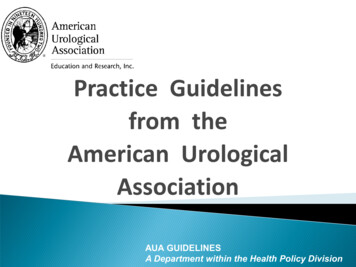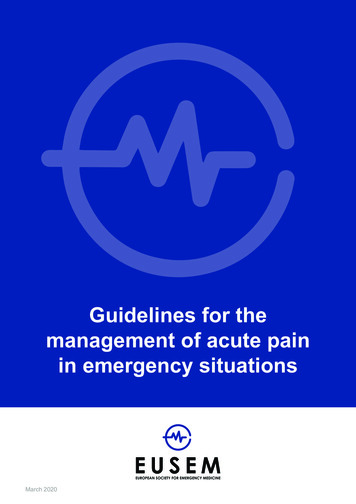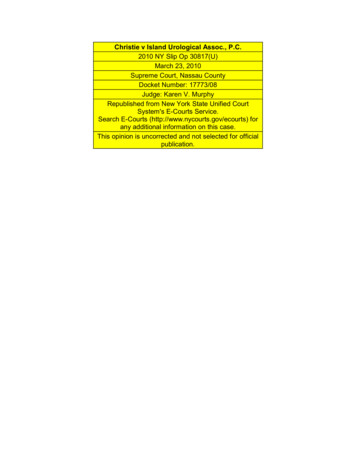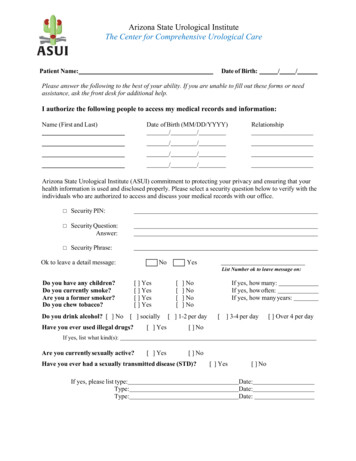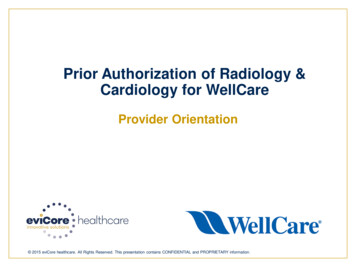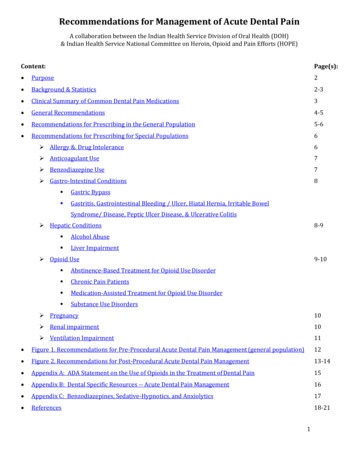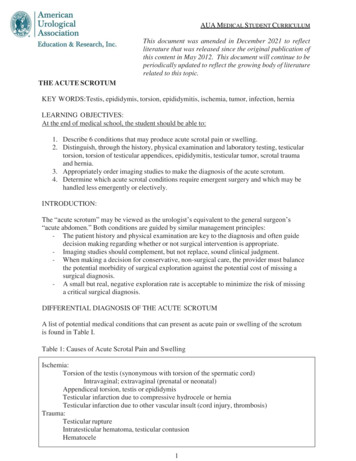
Transcription
AUA MEDICAL STUDENT CURRICULUMThis document was amended in December 2021 to reflectliterature that was released since the original publication ofthis content in May 2012. This document will continue to beperiodically updated to reflect the growing body of literaturerelated to this topic.THE ACUTE SCROTUMKEY WORDS:Testis, epididymis, torsion, epididymitis, ischemia, tumor, infection, herniaLEARNING OBJECTIVES:At the end of medical school, the student should be able to:1. Describe 6 conditions that may produce acute scrotal pain or swelling.2. Distinguish, through the history, physical examination and laboratory testing, testiculartorsion, torsion of testicular appendices, epididymitis, testicular tumor, scrotal traumaand hernia.3. Appropriately order imaging studies to make the diagnosis of the acute scrotum.4. Determine which acute scrotal conditions require emergent surgery and which may behandled less emergently or electively.INTRODUCTION:The “acute scrotum” may be viewed as the urologist’s equivalent to the general surgeon’s“acute abdomen.” Both conditions are guided by similar management principles:- The patient history and physical examination are key to the diagnosis and often guidedecision making regarding whether or not surgical intervention is appropriate.- Imaging studies should complement, but not replace, sound clinical judgment.- When making a decision for conservative, non-surgical care, the provider must balancethe potential morbidity of surgical exploration against the potential cost of missing asurgical diagnosis.- A small but real, negative exploration rate is acceptable to minimize the risk of missinga critical surgical diagnosis.DIFFERENTIAL DIAGNOSIS OF THE ACUTE SCROTUMA list of potential medical conditions that can present as acute pain or swelling of the scrotumis found in Table I.Table 1: Causes of Acute Scrotal Pain and SwellingIschemia:Torsion of the testis (synonymous with torsion of the spermatic cord)Intravaginal; extravaginal (prenatal or neonatal)Appendiceal torsion, testis or epididymisTesticular infarction due to compressive hydrocele or herniaTesticular infarction due to other vascular insult (cord injury, thrombosis)Trauma:Testicular ruptureIntratesticular hematoma, testicular contusionHematocele1
Infectious conditions:Acute epididymitisAcute epididymoorchitisAcute orchitisAbscess (intratesticular, intravaginal, scrotal skin, cutaneouscysts)Gangrenous infections (Fournier’s gangrene)Inflammatory conditions:Henoch-Schonlein purpura (HSP) vasculitis of scrotal wallFat necrosis, scrotal wallHernia:Incarcerated, strangulated inguinal hernia, with or without associated testicularischemiaAcute on chronic events:Spermatocele, rupture or hemorrhageHydrocele, rupture, hemorrhage or infectionTesticular tumor with rupture, hemorrhage, infarction or infectionVaricoceleWhile the differential diagnosis is broad, an accurate history and physical examination canfrequently precisely define the condition. Often, carefully chosen imaging studies cancomplement clinical judgment and expedite therapeutic decisions. A discussion of the mostimportant and common conditions that cause acute scrotal pain or swelling follows.TORSIONTesticular torsionThe testicle is typically covered by the tunica vaginalis, creating a potential space around thetestis. Torsion can occur from within the tunica vaginalis or about the entire spermatic cord.Normally, the tunica vaginalis attaches to the posterior surface of the testicle and allows for verylittle mobility of the testicle within the scrotum. Some patients have an inappropriately highattachment of the tunica vaginalis, such that the testicle can rotate freely on the spermatic cordwithin the tunica vaginalis (intravaginal testicular torsion) (Figure 1). This congenital anomaly,called the “bell clapper deformity,” consists of a transverse as opposed to longitudinal lie of theaffected testis; it can be unilateral or bilateral and is a risk factor for a torsion event. Thiscongenital abnormality is present in approximately 12% of human males.Figure 1. Bell clapper deformity.Normal testis lie is on the left andthe classic “bell clapper” lie is inthe middle. The right side shows abell clapper variation.2
Experimental evidence indicates that 720 twist is required to compromise flow through thetesticular artery and result in ischemia, however the degree of twist is different in each clinicalpresentation. In neonates, the testicle frequently has not yet descended into the scrotum, afterwhich it becomes attached within the tunica vaginalis. This increased mobility of the testiclepredisposes it to extravaginal testicular torsion. During testis torsion, the testicle twistsspontaneously on the spermatic cord, causing venous occlusion and engorgement, withsubsequent arterial ischemia and infarction.Testis torsion is the most common cause of testis loss in the US. The incidence in males 25years old is approximately 1:4000. Torsion more often involves the left testicle. Amongneonatal testicular torsion cases, 70% occur prenatally and 30% occur postnatally. The testissalvage rate approaches 100% in patients who undergo detorsion within 6 hours of the start ofpain. However there is only a 20% viability rate if torsion persists 12 hours; and virtually noviability if torsion persists 24 hours (Figure 2).Figure 2. Testis histologyduring early (A) hemorrhagicphase and chronic late (B)phases of testis torsion. Note thedecreased seminiferous tubulediameter and loss of germ cellsin late relative to early phases.Testicular torsion presents with the rapid onset of severe testicular pain and swelling (Figure 3).The onset of pain may be preceded by trauma, physical activity, or by no activity (e.g. duringsleep). It most often occurs in children or adolescents, but this diagnosis should be considered inevaluating men with scrotal pain of any age, as it may occasionally occur in men 40-50 yearsold. In this age group, the diagnosis is often delayed or missed due to a low suspicion because ofage. Torsion should be in the differential for any sudden acute scrotal pain or swelling.The classic physical examination findings with testis torsion are an exquisitely tender testiclewith a high, horizontal lie. Normally the testicle has a vertical lie within the tunica vaginalis ofthe scrotum – that is, the longitudinal axis of the testis is oriented vertically. With torsion andtwisting of the spermatic cord, the testis may assume an altered lie based on the degree oftwisting. After venous outflow is occluded, there is swelling and occlusion of arterial flow.Early on, one may be able to palpate the torsed cord and the testis below it; later in the course,however, progressive edema and inflammation ensues, such that after 12-24 hours, the entirehemiscrotum appears as a confluent mass without identifiable landmarks. At this stage, thephysical examination may be indistinguishable from that seen with epididymoorchitis.Importantly, with torsion, signs of infection are usually absent: patients are usually afebrile, freeof irritative voiding symptoms such as dysuria, and harbor a normal urinalysis and normalwhite blood cell count. (In later torsion, however, an elevated WBC may be seen in response tothe inflammation). Torsion of an undescended testicle will present differently than that of adescended testicle. For example, it may mimic the presentation of inguinal hernias or an acuteabdomen, and there may not be scrotal swelling.3
Figure 3. Example of acute scrotumhighlighting hallmark signs of testiculartorsion, including color change andswelling (from Al-Salem AH: AcuteScrotum. In: Atlas of Pediatric Surgery.Springer, Cham. (2020)).With a high degree of suspicion, one may reasonably recommend surgical explorationwithout delay. When the diagnosis is less clear, the TWIST score is a useful clinicaldecision tool used to characterize torsion risk based on history and physical exam. Patientswith intermediate risk TWIST scores should undergo scrotal ultrasonography, if readilyavailable, as this test is the single most useful adjunct to the history and physicalexamination in the diagnosis of torsion. The ultrasonographer should use Doppler flow toassess arterial flow within the affected testis; if arterial flow is absent, or decreasedrelative to the contralateral testis, then torsion is highly likely. It is helpful to compare theflow patterns between both testes to help make this diagnosis. Ultrasonography may alsoexclude significant testicular trauma, show a hernia extending into the scrotum, and candistinguish epididymitis from torsion by demonstrating increased flow to the epididymisand adnexal structures along with preserved testicular perfusion. Evaluation ofintratesticular flow should include a comparison of the contralateral testis, as well as theipsilateral epididymis. Sonographic findings should be considered within clinical context.For example, a perceived increase in epididymal blood flow may be due to decreasedintratesticular blood flow. Similarly, a “complex mass” superior to the testis mightrepresent an inflamed epididymis or a torsed appendix, epididymis, or testis. The torsedcord with edema and inflammation is difficult to distinguish from an inflamed epididymisin torsion. Remember, testicular perfusion is the key to the ultrasound diagnosis oftorsion. Tests such as nuclear testicular scans, CT or MRI, have essentially no role in thecontemporary management of acute testicular processes.When torsion is diagnosed, urgent surgical exploration and detorsion is mandated, astesticular torsion is a true vascular emergency. Testicular preservation is excellent whencorrected within 4-6 hours of onset. Beyond 12 hours, the risk of subsequent testis atrophyis significant with detorsion. Testis salvage is often still appropriate if the testicularappearance at exploration improves with observation following detorsion, manually orotherwise. Manual detorsion is typically performed via the “opening the book” maneuver,as most testes torse toward the septum of the scrotum, however this should be considered4
an adjunct to definitive treatment. In the acute setting ( 24 hours of symptom onset),detorsion should be attempted at the presenting institution when technically feasible, assalvage rates are lower for patients who are transferred to another hospital.The definitive treatment for testicular torsion is scrotal exploration. After sharply enteringthe scrotum, the tunica vaginalis is opened. Then the testis detorsed and wrapped in awarm, moist gauze. In patients with torsion, it is assumed the bell-clapper deformity isbilateral, and thus the contralateral side then undergoes orchidopexy with permanent sutureto prevent torsion on that side. The affected testis is reinspected for signs of improvedperfusion (“pinking up”) (Figure 4). If the testis appears viable, or the timeframe suggeststhat salvage is reasonable then orchiopexy is performed by anchoring the tunica albugineaof the testis to the overlying parietal tunica vaginalis and scrotal dartos muscle withpermanent suture.Figure 4. Exploration of torsed testis. Note dark, cyanotic colorof testis following 30 minutes of detorsion suggesting nonviability.In general, scrotal exploration is a procedure of low morbidity. A negative explorationseldom results in long term complications. When weighing conservative treatment with theloss of a potentially salvageable testis, it is best to err on the side of exploration. In cases of“late torsion” or “established torsion,” exploration generally reveals a hemorrhagic, franklynecrotic testis for which orchiectomy should be performed.“Intermittent” testicular torsion is a well-recognized entity in which a classic torsionhistory is obtained, but physical examination and ultrasound findings are normal. In suchcases, it is reasonable to offer an elective bilateral scrotal orchiopexy for the possibility ofintermittent symptoms becoming full-fledged torsion.Torsion of testicular or epididymal appendagesSmall polypoid appendages are often found attached to the testis or epididymis and are eitherMullerian or Wolffian duct remnants (Figure 5). Similar to testis torsion, torsion of the appendixtestis or appendix epididymis can also present with the acute onset of scrotal pain and mass. Inmost cases, however, the testis is palpable and has a normal lie. If encountered early, theedematous, torsed appendage can often be palpated at the upper pole of the testis. If the torsedappendage is ecchymotic, it can usually be seen through the skin and represents the "blue-dotsign." Doppler ultrasound will demonstrate a normally perfused testis, often withhypervascularity in the area of the appendage. This process is often self-limited, with theinfarcted appendage undergoing atrophy with time.5
Figure 5. Illustration of the common appendices of thetestis and epididymis. The appendix testis is mostcommonly affected by torsion.If exploration is pursued, the appendage is simply excised and no orchidopexy is needed.Later in its course, it can be more difficult to distinguish this entity from testicular torsionor epididymitis, as global enlargement and edema of the scrotal compartment may occur.Ultrasound is valuable here to identify normal blood flow to the testis.TRAUMAPenetrating and blunt testicular injuryTesticular rupture results when there is laceration of the tunica albuginea of the testis, suchthat testicular parenchyma may extrude. It may occur from either blunt or penetratingtrauma. As a general principle, penetrating injuries to the scrotum should be surgicallyexplored. The risk of testicular injury is quite high with these injuries and the role ofultrasound in the diagnosis of testicular rupture in this setting is limited. Even penetratinginjuries with a tangential trajectory have a high likelihood of injuring the testis or cordstructures. In cases of blunt trauma, however, the incidence of testicular rupture varieswidely, and depends on the forces exerted, the mechanism of injury, and testis mobility.Following blunt injury, the physical examination findings may include swelling, tendernessor ecchymosis. If one can clearly palpate the testis and it is entirely normal to palpation,rupture is unlikely. If there is significant scrotal wall thickening from edema or hematoma,testicular palpation may be difficult or impossible, and scrotal ultrasonography candetermine the degree of testis injury with a high level of accuracy. In addition todemonstrating a break in the continuity of the tunica albuginea or evidence of extrudedparenchyma, ultrasound evidence of a marked loss of internal homogeneity of the testis ishighly predictive of testicular rupture and warrants surgical exploration. Blunt injury mayresult in testicular rupture, intratesticular hematoma, testicular contusion (bruising) orhematocele (blood collection within the tunica vaginalis space). Among these, onlytesticular rupture requires surgical repair, though surgical exploration is indicated for largehematomas or imaging that fails to rule out rupture. Large or painful hematoceles maybenefit from drainage. For intratesticular hematoma (intact tunica albuginea, localizedhematoma within an otherwise intact testis) or local tenderness (contusion), observation,rest, cold packs and analgesics are appropriate therapy.Surgical exploration for trauma is performed through incisions that anticipate the structures atrisk. For penetrating trauma, a vertical incision may be easily extended into the groin toexpose the spermatic cord. For blunt trauma, a transverse incision over the injured scrotalcompartment is effective. After inspecting and draining the tunica vaginalis space, any6
extruded testicular parenchyma is inspected, irrigated and resected or retained and tunicallacerations repaired. The testicular compartment may be drained, generally with a smallPenrose drain. With trauma, most testicular injuries are amenable to repair. Orchiectomy isindicated when there is major injury to the spermatic cord with organ devitalization, anddestruction of parenchyma is so extensive that no significant tissue can be salvaged.INFECTIONSEpididymitis and epididymoorchitisAlthough they may be difficult to distinguish on physical examination from scrotal trauma ortestis torsion, it is important to accurately diagnose epididymitis and orchitis, as theirmanagement is entirely nonsurgical. Epididymitis is usually caused by infections. In men 35years old with a history of sexually transmitted infection (STI) exposure, recent sexualactivity, epididymitis is often caused by Chlamydia or gonococcal infection, and is generallyamenable to treatment with ceftriaxone and doxycycline. In older men and those withproblems such as significant benign prostatic hypertrophy (BPH), a history of UTIs, orurethral stricture disease, enteric, gram negative bacteria related to ascending urinaryinfection are much more likely causes and warrant the empiric use of a fluoroquinolone, suchas levofloxacin. In either case, initial broad-spectrum antibiotics should be used until cultureresults direct further therapy. There are also noninfectious or inflammatory forms ofepididymitis. These are due to the adverse effects of medications, urinary reflux within theejaculatory ducts, and sperm and fluid extravasation after vasectomy. When epididymitisextends into the testis and causes testicular tenderness and enlargement, it is termedepididymoorchitis.There are several features in the patient history that may indicate epididymitis, such as ahistory of previous STI, recent sexual activity, irritative voiding symptoms, BPH/incompleteemptying of the bladder, or UTI. The very sudden onset of pain and swelling is more typicalof torsion, while a more gradual, progressive onset pain (often greater than 24 hours) suggestsepididymitis. On physical examination, epididymitis presents with tenderness posterior andlateral to the testis (the usual location of the epididymis). Scrotal ultrasound may show anenlarged, hyper vascular epididymis with normal or increased blood flow to the testis, whichwill distinguish this condition from torsion or trauma. Abscess formation within theepididymis or in the peri- epididymal tissues, can also be detected by ultrasound. Thediagnostic challenge occurs when trying to distinguish advanced epididymoorchitis from latetorsion. In both entities, there is typically a confluent mass in the scrotum with edema andfixation of the overlying scrotal wall that obliterate normal anatomic landmarks. Furthermore,advanced epididymoorchitis can result in testicular ischemia and infarction due tocompression of the testicular vasculature from epididymal inflammation. On ultrasound, thismay present in a very similar manner to testis torsion. In either case, the lack of testis bloodflow on Doppler ultrasound requires surgical exploration which allows these conditions to bedifferentiated.When diagnosed, epididymitis and orchitis are managed conservatively with antibiotics, antiinflammatories, analgesics, rest and scrotal elevation. If abscess formation occurs, surgicaldrainage and/or orchiectomy may be necessary.7
Scrotal wall infectionsInfectious conditions within the scrotal wall are also classified under the acute scrotum andinclude cellulitis and fasciitis (gangrene). Scrotal wall cellulitides and abscess formation aredistinguishable from testicular conditions on physical examination, as the testis is usuallypalpably normal and nontender, if it can be palpated without compressing the inflamed scrotalwall. Scrotal wall infections may result from infected sebaceous cysts, folliculitis, or otherdermatologic conditions. Incision and drainage with gauze packing and broad-spectrumantibiotics are prescribed for these superficial conditions. Fasciitis of scrotum and groin, termedFournier’s gangrene, involves a rapidly progressive, life threatening infection of the genital softtissues. It is associated with predisposing issues including urethral perforation and periurethralabscess and is most often seen in the immunocompromised or diabetic patient. On physicalexamination, there can be diffuse enlargement, thickening and erythema of the scrotal wall,groin and perineum. There may be necrotic black or ecchymotic patches of genital skin present(Figure 6).Figure 6. Fournier’s gangrene of the scrotum.Note necrotic, black patch of scrotal skin with largeulceration. (From: Aho T et al. (2006) Fournier'sgangrene Nat Clin Pract Urol 3: 54–57)The most diagnostic is the finding of crepitus, a spongy, cracking feeling within the skin thatindicates gas-producing microorganisms underneath that can be felt in the scrotum or perineum.When left untreated, genital gangrene will progress over hours and result in overwhelmingbacterial sepsis with an associated high mortality rate. Therefore, broad spectrum antibioticsthat cover aerobic and anaerobic organisms, and urgent and repeated surgical drainage anddebridement are required to control the infection. In a clinically stable patient, CT may beadvantageous to identify a perirectal abscess, rectal process, or for the tracking of air beneath indeeper tissues and following fascial planes. At the time of surgical treatment, cystoscopy andproctoscopy may be performed to exclude urethral and rectal abnormalities.Scrotal wall inflammationHenoch-Schonlein purpura (HSP) is a vasculitis of scrotal wall that causes thickening anderythema in the absence of infection (Figure 7). Idiopathic scrotal edema and filarial infections(rare in the US) can also cause chronic, relatively painless, scrotal swelling. Lastly, scrotaledema secondary to hypoalbuminemia, portal hypertension and lymphadenopathy are also rarebut significant conditions that may occur under the aegis of the acute scrotum. In most of theseconditions, the history of a slowly progressive disease process helps differentiate them frommore classically acute conditions. Treatment of the underlying, non-scrotal cause is mosteffective to relieve the scrotal symptoms.8
Figure 7. Characteristic scrotal erythema in Henoch-Schonleinpurpura. (From: Modi S et al.: Acute Scrotal Swelling in HenochSchonlein Purpura: Case Report and Review of the Literature.Urol Case Rep. (2016) 6:9-11.)INGUINAL HERNIAAn acute inguinal hernia may also present as an acute scrotum. In this case, pain and swellinginvolve both the scrotal contents and the groin area. Although important to differentiate, it maybe difficult to distinguish an incarcerated inguinal hernia from other, less emergent, scrotalissues such as hydrocele, scrotal trauma, or scrotal abscess. An incarcerated inguinal herniainvolves bowel that is obstructed and is a true surgical emergency. In selected, less acute cases,groin and scrotal ultrasound or pelvic CT scans can clarify the diagnosis before surgicalexploration. Hernia repairs that use polypropylene mesh for correction may be associated withvas deferens obstruction and infertility later on.ACUTE ON CHRONIC EVENTSOther scrotal conditions that are chronic in nature can also present with acute symptoms andinclude testicular neoplasms, spermatoceles and hydroceles. In the case of testis tumors,patients may only become aware of the mass after it has been present for many months, after itaffects the appearance of the scrotum. However, testicular tumors can present precipitously ifthey undergo hemorrhage or necrosis, and produce swelling, pain and soreness. In this case, ascrotal physical examination reveals a firm, intratesticular mass and scrotal ultrasounddemonstrates a solid intratesticular mass which has a 90% likelihood of being a germ celltumor. The suspicion of tumor is important for the approach to exploratory surgery in the acutescrotum, as the correct surgical approach to testis cancer is through an inguinal incision and nottranscrotally. In addition, the testis and its investments are dissected out intact, to minimizetumor spillage during surgery and spermatic cord ligation is done in the inguinal region tofurther contain the spread of cancer.Other chronic scrotal lesions which can present acutely include hydroceles (increased fluidwithin the tunical vaginalis space) and spermatoceles (cystic dilation of the fine ducts that leadfrom the rete testis to the epididymal head) that hemorrhage after trauma, or become infected.In addition, a scrotal varicocele, a condition characterized by dilated pampiniform plexus veinsand that occurs in 15% of men at puberty, can be present for years but become acutelysymptomatic. These dilated veins surround the spermatic cord. If the varicocele has acuteonset, is only right-sided, or persists in the supine position, then inferior vena caval (IVC)obstruction must be excluded (i.e., IVC thrombus, abdominal mass, etc.). A careful history,9
physical examination and ultrasound examination is usually sufficient to diagnose these usuallybenign acute on chronic events. Urgent surgical intervention is rarely needed for drainage of aloculated infection or for a persistent hemorrhage associated with hydroceles or spermatoceles.SUMMARY A full range of scrotal pathology must be considered in acute scrotum cases. Several conditions that result in acute scrotum require surgical exploration, making thisa very time sensitive condition. A high value is placed on the history, physical examination and ultrasound imagingfor acute scrotum diagnoses.REFERENCES:Meacham RB: Potential for vasal occlusion among men after hernia repair using mesh. Journalof Andrology. (2002) 23:759-761.Joyner B & Walsh T: Evaluation of the Pediatric Patient with a Non-Traumatic Acute Scrotum:AUA Update Series (2005), Volume 25, Lesson 12.Kim SH et al.: Significant predictors for determination of testicular rupture on sonography: aprospective study. Journal of Ultrasound Med. (2007) 26:1649-1655.Lin EP et al.: Testicular torsion: twists and turns. Semin Ultrasound CT MR. (2007) 4:317-328.Callewaert PR et al.: New insights into perinatal testicular torsion. Eur J Pediatr. (2010)169:705–712.Sheth KR et al. Diagnosing Testicular Torsion before Urological Consultation and Imaging:Validation of the TWIST Score. The Journal of urology. (2016) 195:1870-6.Kwenda EP et al.: Impact of hospital transfer on testicular torsion outcomes: A systematicreview and meta-analysis. J Pediatr Urol. (2021) 17:293.e1-293.e8.Tracy CR et al.: Diagnosis and management of epididymitis. Urol Clin North Amer.(2008) 35:101-108.Morey AF et al.: Urotrauma Guideline 2020: AUA Guideline. J Urol. (2021) 205:30-35.Dupond-Athénor A et al.: A multicenter review of undescended testis torsion: A plea for earlymanagement. J Pediatr Urol. (2021) 17:191.e1-191.e6.10
AUTHORS2021Kathleen Kieran, MD, FACS, FAAP, MScSeattle, WADisclosures: Nothing to DiscloseBrendan Kiely Wallace, BSNew York, NYDisclosures: Nothing to Disclose2018Elizabeth Takacs, MDIowa City, IADisclosures: Nothing to Disclose2016Seth Cohen, MDArcadia, CADisclosures: WebMD, Health Publishing; American Urogynecologic Society, LeadershipPosition; MicrobeDx, Consultant or AdvisorWilliam Gans, MDWest Palm Beach, FLDisclosures: Opko, Investment Interest2012Bruce Slaughenhoupt, MDMadison, WIDisclosures: Nothing to disclose 2021 American Urological Association Education and Research, Inc. All Rights Reserved11
called the "bell clapper deformity," consists of a transverse as opposed to longitudinal lie of the affected testis; it can be unilateral or bilateral and is a risk factor for a torsion event. This congenital abnormality is present in approximately 12% of human males. Figure 1. Bell clapper deformity. Normal testis lie is on the left and


